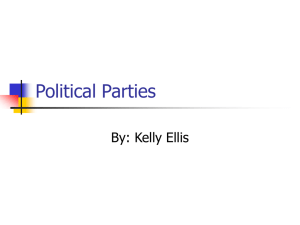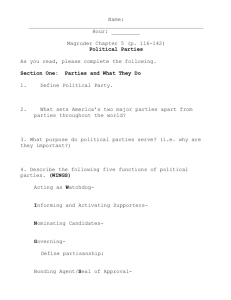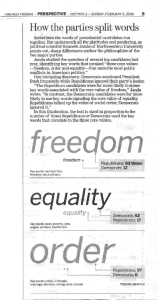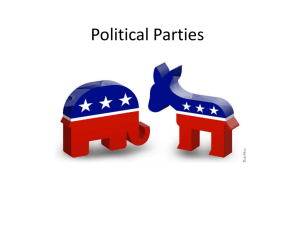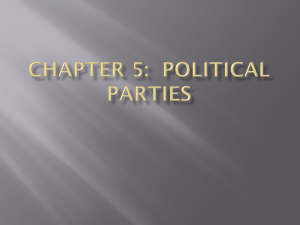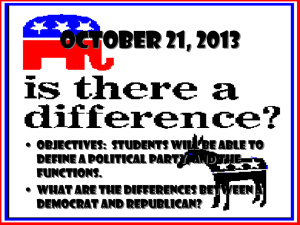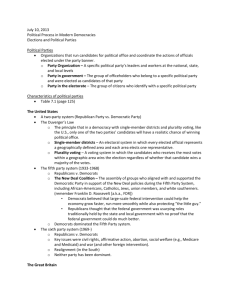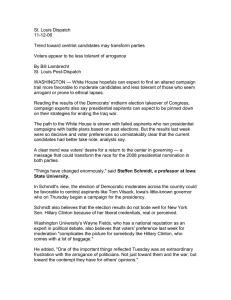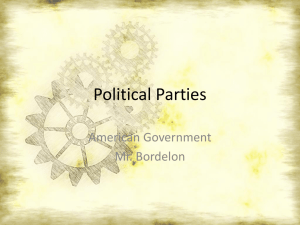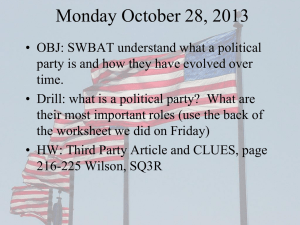Chapter 5 Political Parties
advertisement
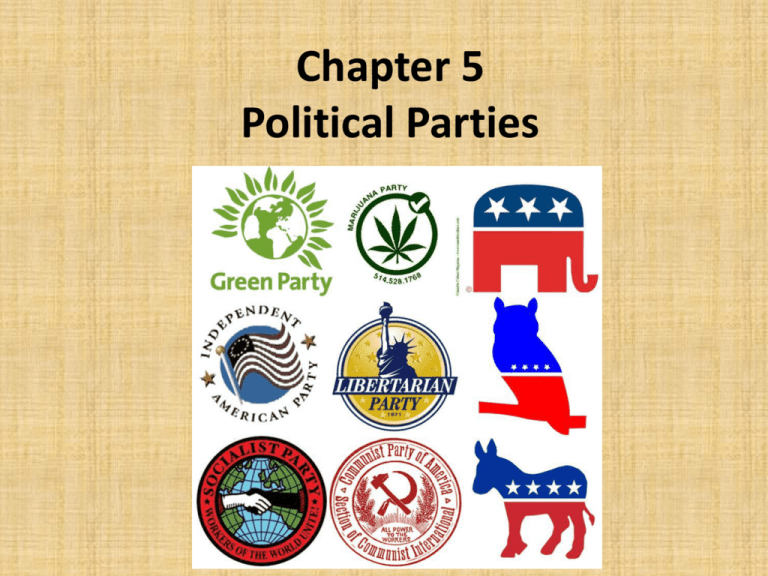
Chapter 5 Political Parties Section 1: Parties and What They Do • Objectives: – Define a political party – Describe the major functions of political parties – Identify the reasons why the United States has a two-party system – Understand multiparty and one-party systems and how they affect the functioning of a political system. What is a Party • A group of persons who seek to control government through the winning of elections and the holding of public office – Democrats and Republicans – Organization made of three separate but closely related elements • The party organization – Leaders, activists, “hangers-on” • The party in government – Party candidates and officeholders • The party in the electorate – People who call themselves Republicans or Democrats What Parties Do • Essential to a Democratic Government • Link between the people and their government • Will of the people made known to the government • Government is held accountable Nominating Candidates • Nominate candidates for a public office – Activity that most clearly sets political parties apart from all of the other groups that operate in the political process Informing and Activating Supporters • Inform and inspire voters – Campaigning – Taking stands on current issues – Criticizing opposing candidates – Inform voters • Propaganda The Bonding Agent Function • Bond – agreement that protects a person or a company against loss caused by a third party – Ensure the good performance of its candidates and elected officeholders Governing • Those who govern are chosen on the basis of party • Partisanship-strong support of their party and its policy stands • Parties must also work together – Executive and legislative branches Political Parties Republican Party Democratic Party Independent Vacant House of Representatives 245 188 0 2 Senate 54 44 2 0 The Watching Function • Parties act as watchdogs over the conduct of the public’s business – Party out of power • Criticizes the party in power The Two-Party System • Republicans and Democrats • Historical Basis – Framers were opposed to political parties – Ratification of the Constitution gave rise to the Federalist and Anti-federalist • The force of Tradition-All that Americans know • The Electoral System-promote two major parties Multiparty Systems • Scrap the two party system • Several major and many lesser parties exist, seriously compete for and actually win public offices – Each party is based on a particular interest • Example: economic lass, religious belief, political ideology. One-Party Systems • Only one political party, the party of the ruling clique is allowed to exist – “no-party” system – Many states have a one party system, gains the majority of the votes all the time Major political parties A party that has "an independent state organization... in a majority of the states" is listed as a major party. An "independent state organization" is not to be confused with the organization of an Independent Democrat or Independent Republican. Political Party States* Founded in Democratic Party 50 + DC 1828 Progressive Alliance Republican Party 50 + DC 1854 International Democrat Union Libertarian Party 48 + DC 1971 Interlibertarians Green Party 36 + DC 1991 Global Greens Constitution 26 Party 1992 Former Titles International Affiliations U.S. Taxpayers' Party Section 2: Two-Party System in American History • Objectives: – Understand the origins of political parties in the United States – Identify and describe the three major periods of single-party domination and describe the current era of divided government The Nation’s First Parties • Federalists – “the rich and the well-born” – Supported the Constitution • Anti-Federalist • Becomes the Democratic party in 1828 – “common man” – Favored a very limited role by the new government • First clashed in the election of 1796 Four Major Eras • 1800-1860 – Democrats won 13 of 15 presidential elections – Lost in 1840 and 1848 • 1860-1932 – Republicans won 14 of 18 elections – Lost in 1884, 1892, 1912, and 1916 • 1932-1968 – Democrats return to power and Franklin Roosevelt’s first election to the presidency The Era of Democrats • Thomas Jefferson’s election in 1800 marked the beginning • Andrew Jackson (1829-1837)-changes in political landscape – 1)voting rights for all white males – 2)a huge increase in the number of elected offices around the country – 3)the spread of the spoils system-the practice of awarding public offices, contracts, and other governmental favors to those who supported the party in power Whig Party • Major party from the mid 1830s to the 1850s – Lead by Henry Clay and Daniel Webster – Elected only two men to the Whitehouse • William Henry Harrison in the 1840s • Zachary Taylor in 1848 – 1850s-Whig Party fell apart The Era of the Republicans • The Civil War signaled the beginning of the second era of one-party sway • Remained the leading party for 75 years The Return of the Democrats • Great Depression-1929 – Massive impact on nearly all aspects of American life • 1932-presidential election-Franklin Roosevelt – New electoral base: southerners, small farmers, organized labor, and big-city political organizations Section 3: The Minor Parties – Objectives: • Identify the types of minor parties that have been active in American politics. • Understand why minor parties are important despite the fact that none has ever won the presidency Minor Parties in the United States • Particular locale, single state, one region of the country – Ideological Parties • Based on a particular set of beliefs – Socialist, Socialist Labor, Socialist Worker and Communist Parties – Single-Issue Parties • Focus on a single public question. Names usually indicate their primary concern – Free Soil Party-opposed slavery in the 1840s – Right to Life Party-opposes abortion today – Economic Protest Parties • Rooted in periods of economic discontent. No clear-cut ideological base. Disappeared as the nation has climbed out of the problem – Splinter Parties • Have split away from one of the major parties – Teddy Roosevelt's “Bull Moose” Progressive Party of 1912-pulled away from Republicans Why Minor Parties are Important • -1st used a national convention to nominate a presidential candidate in 1831 • Can play a third party candidacy-spoiler role Section 4: Party Organization • Objectives: – Understand why the major parties have a decentralized structure – Describe the national party machinery and party organization at the State and local levels Decentralized Nature of the Parties • Myth – Often described as highly organized, close-knit and well disciplined • Truth – Highly decentralized, fragmented and often plagued by factions and internal squabbling • Neither party has a chain of command running from the national through the State to the local level – Presidents party is usually more organized and united than the minor party. President is leader of the party National Party Machinery • Both major parties are composed of five basic elements – National Convention • Pick the party’s presidential and vice presidential candidates, adoption of the party’s rules and the writing of its platform – National Committee • Reps from each state and territories, plan national convention – National Chairperson • Leader of the National Committee, directs the work of the party’s headquarters and professional staff – Congressional Campaign Committees • Each party has a campaign committee in each house of Congress, work to get seats for their party. State and Local Party Machinery • At the State and local levels, party structure is determined by State Law – State Organization • Built around a state central committee, headed by a State Chairperson. Republicans: Jeff Essmann Democrats: Jim Elliott
